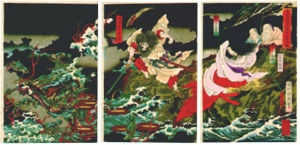Yamata no Orochi (八岐の大蛇||"big snake of eight branches") often called Orochi or the Eight-Forked Serpent is a serpent-like creature in Japanese mythology.
Description
The monster is described as having eight heads and eight tails and eyes as red as winter-cherries. It is so long its body extends over eight valleys and eight hills, its belly is always bloody and inflamed, and its back is covered with hikage (clubmoss), hinoki (Japanese cypress), and sugi (Japanese cedar).
Story
In the Kojiki, an ancient Japanese scripture, Susa-no-Ō, after is expelled from Heaven, encounters two Kuni-tsu-Kami ("earthly deities") near the head of the Hi-i-gawa ("Hi'i river") in Izumo Province. They are weeping because they have had to give the Orochi one of their daughters once every year, and now they must sacrifice their eighth and last, whose name is Kushi-inada-hime.
Susa-no-Ō asks for Kushi-inada-hime's hand in marriage, and then transforms her into a comb (kushi) which he places in his hair. He then asks her parents to brew some sake that has been refined eight times, and then build a round enclosure with eight gates, each with a platform and a sake vat. They fill the sake vats and wait, and sure enough the Orochi appears. It dips a head into each vat, and is soon intoxicated, allowing Susa-no-Ō to cut it into pieces. When he cuts the middle tail, his sword is chipped, and there he finds the legendary sword, Kusanagi-no-Tsurugi.
See also

